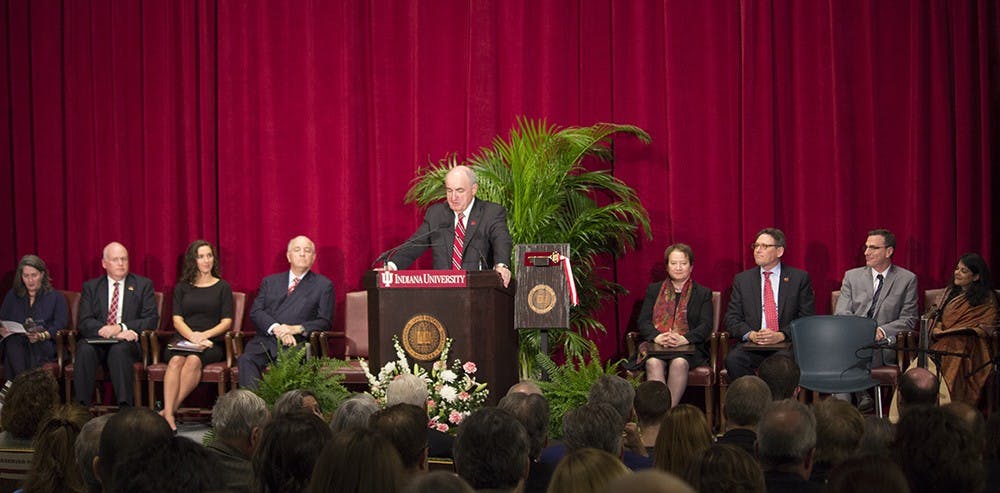The IU School of Global and International Studies and the College of Arts and Sciences had a dedication ceremony for the new Global and International Studies building Wednesday.
Designed by Susan T. Rodriguez of Ennead Architects of New York, the $53 million building is home to more than 20 academic programs in eight departments.
The building was funded entirely by previously existing IU revenue, half of which came from IU’s share of proceeds from the Big Ten Network contract.
IU President Michael McRobbie presided over the ceremony.
“Today, we celebrate a historic milestone in the life of Indiana University,” McRobbie said. “We celebrate a facility that will help prepare this generation, and future generations, to collaborate across cultures and with other nations.”
McRobbie said the building was designed to foster the collaboration and cross-disciplinary research necessary in addressing difficult questions and galvanizing global developments.
“Our goal is to create a truly global research and educational environment where specialists in one part of the world might work side by side with scholars focusing on another part of the world, exploring common problems from diverse perspectives,” McRobbie said.
IU-Bloomington Provost and Executive Vice President Lauren Robel spoke after McRobbie.
By bringing students, faculty and staff from all corners of IU’s campus together, Robel said the GISB will encourage interdisciplinary and interpersonal explorations of what it means to be a citizen of the world today.
“This building is not only a tribute to the incredible transformation of Indiana University during the 20th century,” Robel said. “It is also a symbol of our commitment to being a force for extraordinary good during the 21st.”
Robel said the GISB also serves as a platform for IU to strengthen its connections with communities around the world.
“In short, the building we celebrate today will be a vibrant hub for international and global activity on our campus for generations to come,” Robel said.
Larry Singell, executive dean of the IU College of Arts and Sciences, spoke after Robel.
“The great American architect, Luis Kahn, once defined architecture as the thoughtful making of space,” Singell said. “I think the Global and International Studies Building is just that.”
Singell said thoughtfully made spaces, such as the Fine Arts Building and the Showalter Fountain, leave lasting impressions that instill a longing to return to IU.
“If you pause in the three-story glass atrium, or in the classrooms that are filled with natural light overlooking the arboretum, you know that the Global and International Studies Building is destined to be one of those places that brings people back to IU,” Singell said.
In addition to being aesthetically pleasing, Singell said he hopes the GISB will help build the foundation for deeper understanding among its visitors.
“I hope that this new home will foreground what we hold in common across languages and cultures,” Singell said. “But it will also make self evident how diversity of thought and opinion inoculate us from the biases that stem from a lack of knowledge and empathy.”
Lee A. Feinstein, founding dean of SGIS, called global studies the “DNA of Indiana University.”
Feinstein said a career in international affairs requires a firm grasp in the humanities as well as the social sciences.
“A liberal arts education is the best preparation for a global career,” Feinstein said. “And what career today is not global?”
The ceremony was followed by a reception in the GISB’s atrium, which contains the Stones of the World monument.
The monument features stones from 10 countries around the world, including Indiana limestone.
“Walking the halls, our students can travel through southern Africa to Russia to Brazil to China, from Afghanistan to India, and to nearly all the places in between,” Singell said. “Thus, no matter where you are or where you have come from, you are home in GISB.”






